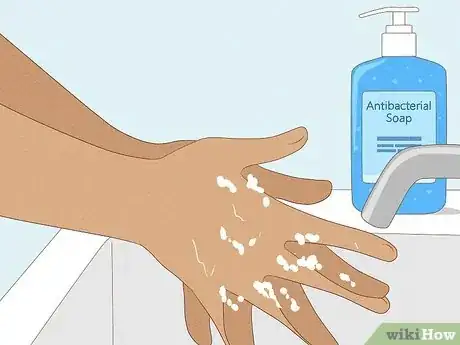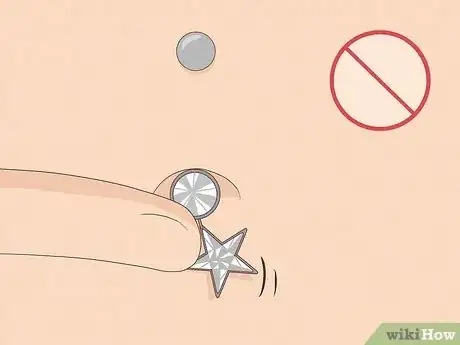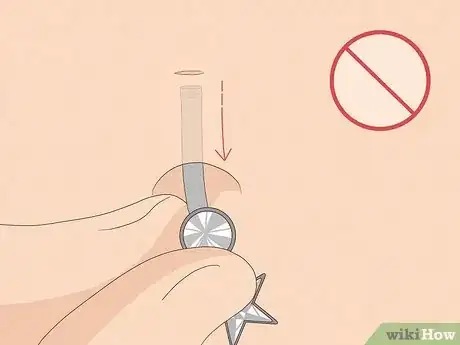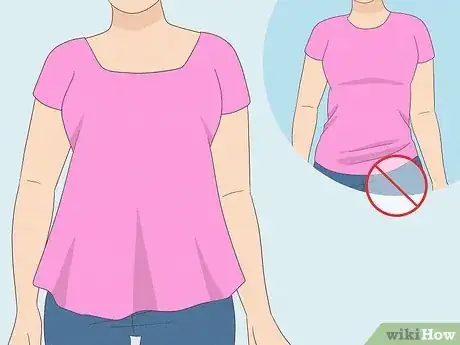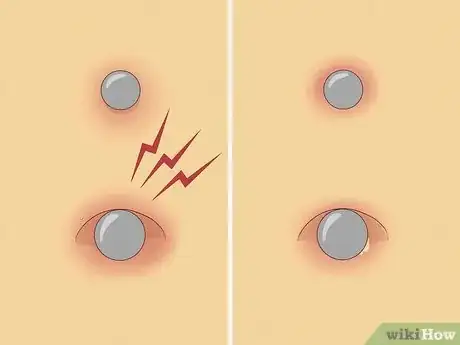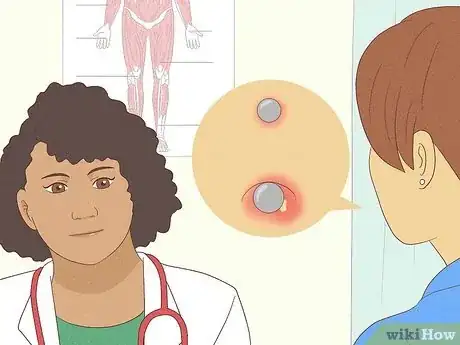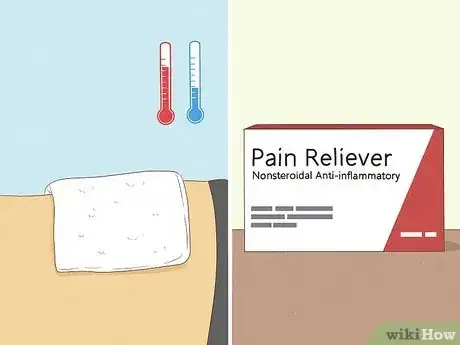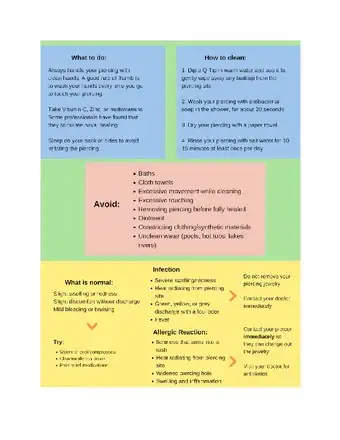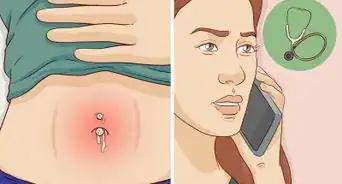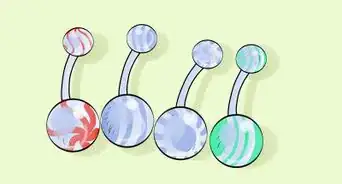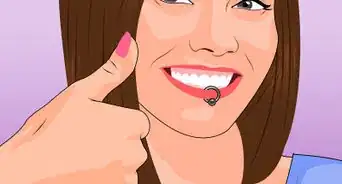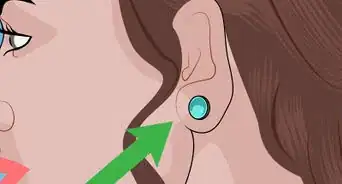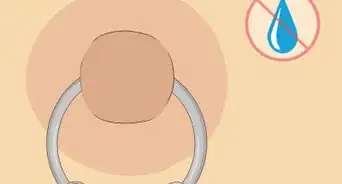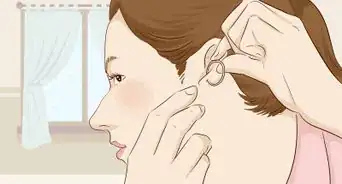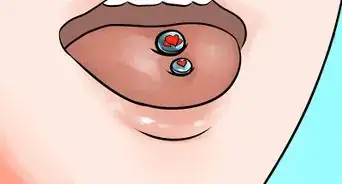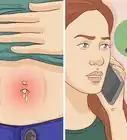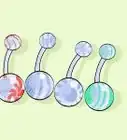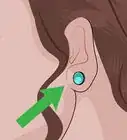This article was co-authored by Sasha Blue. Sasha Blue is a Professional Body Piercer and the Owner of 13 Bats Tattoo and Piercing Studio in the San Francisco Bay Area. Sasha has over 20 years of professional body piercing experience, starting with her apprenticeship in 1997. She is licensed with the County of San Francisco in California.
There are 13 references cited in this article, which can be found at the bottom of the page.
wikiHow marks an article as reader-approved once it receives enough positive feedback. This article received 15 testimonials and 93% of readers who voted found it helpful, earning it our reader-approved status.
This article has been viewed 1,609,583 times.
Getting a new piercing is always a thrilling experience. However, to ensure that your navel piercing remains a satisfying addition to your appearance, you have to keep your piercing clean and healthy. To keep your piercing healthy, all you have to do is incorporate a thorough cleaning routine during the healing process, while consciously avoiding some irritants that could prevent adequate recovery.
Steps
-
1Handle your piercing with clean hands. Wash your hands thoroughly with antibacterial soap and water before you touch your piercing with your fingers.[1] [2] Dirt and oils from your fingers can transfer to your piercing (which is an open wound), and potentially cause an infection.
- Try to make sure to use your nails to scrape out and remove any dirt from underneath your nails. Dirt from underneath your nails could also transfer to and infect your piercing as you touch it.
-
2Wash your piercing daily. Use a Q-Tip dipped in warm water to wipe and remove any built up crust from around the piercing site. Do this very gently, avoiding moving the jewelry around too much. Then, wash your piercing with antibacterial soap in the shower. Simply add a small amount of soap to your fingertips, and massage and lather the soap onto your piercing for about 20 seconds.[3] Use the shower water to thoroughly rinse off the soap residue. Exit the shower and dry your piercing using a dry paper towel rather than a bath towel.
- Your piercing should be washed with soap twice a day. However, you can use a Q-Tip dipped in water or salt water to remove crust as well. Just try not to clean it with a Q-Tip more than 3 times a day. You want to avoid over cleaning the piercing.
- You should always shower rather than taking a bath. With a shower, you have a steady stream of clean water, whereas a bath contains standing water mixed with sweat, dirt, and residue from your bathing products.
- It's better to dry your piercing using paper towels, since they are clean and disposable.[4] Bath towels, on the other hand, can harbor moisture and bacteria.
- Avoid twisting or turning your piercing too much while you clean it in the shower. Any excessive movement can cause irritation and bleeding.
Advertisement -
3Rinse your piercing with saltwater. Mix ¼ teaspoon of sea salt into 8 oz of boiled water. Wait for the water to cool so it’s warm, yet comfortable to the touch. Pour this salt water mixture into a small glass, lean over (so your stomach is relatively perpendicular to the top rim of the glass), securely put the glass on your stomach, and hold it tightly in place as you lay down on your back. Allow this vacuumed glass of salt water to soak on your piercing for 10-15 minutes at least once a day.[5] The saltwater is highly effective in fighting off bacteria, and can help in removing crust from the piercing site.
- You could also make a warm compress with salt water and a folded up paper towel, or use a sterile sea-salt spray purchased from your local drug store.
-
4Take vitamins. Some piercing professionals have found that taking vitamins such as Vitamin C, Zinc, or multivitamins are beneficial in stimulating navel piercing healing.[6] Getting vitamin D exposure from the sun may also help promote healing of your navel piercing.
Avoiding Irritation To The Piercing
-
1Keep from touching your piercing. Of course it’s appropriate to touch your piercing with clean hands while you wash it, but avoid playing with, twisting, pulling, or fondling your piercing unnecessarily.[7] [8]
- Any excessive touching (especially with unwashed hands) can make your piercing more susceptible to opening up and bleeding, or becoming infected.[9]
-
2Leave the jewelry in place. Your initially piercing jewelry should stay in place for the duration of the healing period (4-10 weeks).[10] Removing your jewelry before your piercing is fully healed can cause your piercing site to close up, which can in turn make reinserting jewelry more difficult and painful.
- This added irritation could potentially create more scarring and slow down your body’s natural healing process.
-
3Avoid applying ointments. Ointments or creams prevent your piercing from coming in contact with air, and breathing. They block out air and seal in moisture at the piercing site with potential bacteria.[11] Even though these ointments might be antibacterial, they can extremely hinder the healing process, and yield an infection.
- Harsh cleansers like hydrogen peroxide and rubbing alcohol should also be avoided. These disinfectants can kill the cells that help rebuild the puncture site of the piercing.
- Cleaning solutions containing Benzalkonium Chloride (or BZK) should also be avoided, as these can similarly inhibit your piercing from properly healing.[12]
- Much like these cleansers, any oils, lotions, sunscreens, and makeup should be kept away from your piercing site. These products can all clog your piercing and encourage an infection.
-
4Wear loose clothing. Tight, constricting clothing can irritate a new piercing because of the friction against the piercing, and its lack of access to fresh air. Try to wear loose-fitting, breathable fabrics like cotton, and stay away from synthetic materials.[13]
- Also be cautious when changing or undressing. Removing your clothes roughly or quickly, increases your chances of snagging your piercing on your clothes, and causing injury.
EXPERT TIPJef Saunders has been piercing professionally for over 20 years. He is the Public Relations Coordinator for the Association of Professional Piercers (APP), an international non-profit dedicated to the educating the public on vital health and body piercing safety, and he teaches piercing for the Fakir Intensives. In 2014, Jef was elected to the Association of Professional Piercers' Board of Directors. In 2015, Jef received the APP President’s Award from Brian Skellie.Professional Piercing Expert
 Jef Saunders
Jef Saunders
Professional Piercing ExpertOur Expert Agrees: Avoid wearing tight materials or clothing that rubs or pulls when you sit or stand. These can irritate new piercings. Most everyday clothes aren't an issue, but a lot of uniforms pose a problem. You also want to make sure you aren't slouching when you sit because that can cause the jewelry to rub into clothes or even get caught in fabric.
-
5Stay away from unclean water. Just like you should avoid taking a bath and instead take a shower, you should also avoid other pools or collections of water. Water areas like swimming pools, hot tubs, and lakes and rivers should be avoided during the first year after your initial piercing.[14]
- This is because all of these water sources could potentially make prolonged contact with your new piercing, with water that might be harboring infecting contaminants.
-
6Sleep on your back or sides. Sleep on your back and sides for the first few weeks after your piercing. This helps to ensure that you don’t apply uncomfortable pressure on your piercing by sleeping on your stomach, while it’s still new and sensitive.[15]
Dealing With Complications
-
1Evaluate your symptoms. If you are experiencing complications with your navel piercing, first assess your symptoms to figure out what issue you might be dealing with. Note any discharges coming from you piercing, the pain level you’re experiencing, any swelling or redness, and any physical changes in the piercing site (like bumps forming, the jewelry changing position, skin opening larger than normal around the metal, etc.). Depending on your symptoms, your piercing may simply be irritated, infected, or you could be having an allergic reaction to the metal.[16]
- The less severe your symptoms are, the more probable it is that you mildly irritated your piercing. The more severe your symptoms are, the more probable it is that your piercing is infected, or you’re experiencing an allergic reaction.
-
2Deal with an irritated piercing. If your piercing was healing normally and you accidentally pulled or tugged on it, slept on it, irritated it with pool water or cosmetics, and are now experiencing some discomfort, you may have slightly irritated your piercing. Your piercing site might also be irritated if the jewelry is too tight or too loose and is moving around too much or pinching your skin. An irritated piercing is indicated with mild discomfort and irritation symptoms. Things like slight swelling, slight redness, and slight discomfort (without severe pain and discharges) qualify as mild irritation symptoms. Maintain your cleaning routine with a saline solution, and treat your piercing as if it were brand new.
- Consider applying a cold compress (consisting of cool water and a small cloth or towel) onto your piercing. This may help relieve some discomfort.
- Leave the jewelry in your piercing. Removing the jewelry may irritate your piercing site even more.
- If you have any questions, consult your piercer, or visit them in person so they can look at your piercing.
-
3Deal with an infected piercing. It is normal to have some discomfort, bleeding, and bruising after getting your navel pierced, but you should also look out for signs of a possible infection. When a navel piercing gets infected, there is usually severe swelling and redness around the piercing site.[17] The piercing site may feel warm or give off a feeling of heat, and can also have green, yellow, or gray discharge accompanied by a foul odor. You may also develop of fever with an infected navel piercing.
- If you believe that your navel piercing has become infected, see a physician as soon as possible. If you are not sure if your piercing is infected, you can contact your piercer to evaluate if your symptoms are normal, or correlative with an infection.
- Do not remove your piercing jewelry if you believe your piercing is infected. Removing your jewelry could irritate the infection and cause your piercing hole to close, preventing your piercing from properly draining.
-
4Deal with an allergic reaction. An allergic reaction might happen hours or days after your initial piercing. Normally, an allergic reaction is your body’s response to being allergic to the jewelry’s metal. Nickel is a common metal that causes an allergic reaction with piercings. Signs of an allergic reaction include itchiness around the piercing site that turns into a rash, heat radiating from the piercing site, a widened piercing hole, or swelling and inflammation around the piercing site.[18] With an allergic reaction, your skin might also loosen or tighten around the jewelry.
- Rejection of the jewelry is a common characteristic with allergic reactions. The skin tries to decrease contact with the jewelry, causing the piercing holes to enlarge and widen.
- In this case, contact your piercer immediately so they can change out the jewelry and you can visit your primary doctor and start treating your piercing site. You may need a prescribed round of antibiotics.
-
5Try some home remedies. If your symptoms are initially mild in nature or think you might be in the beginning stages of an infection, consider trying some home remedies to fix the problem before having to consult a doctor. A few soothing home remedies include:
- Compresses. As mentioned earlier, both warm and cold compresses can relieve discomfort with irritated piercings. A warm compress dipped and wrung out with a saline solution can clean out the area while promoting blood flow (healing white blood cells) to the irritated area.[19] A cool compress can soothe the hot feeling radiating from the piercing site.
-
Chamomile tea soaks. Steep a bag of chamomile tea in a cup of boiling water. Wait for the tea to cool (approximately 20 mins) and dip a cotton ball into the tea. Use the cotton ball to soak your irritated piercing for approximately 5 minutes. Repeat this if desired at least once a day.
- You could also freeze the tea into ice cubes, and use the tea ice cubes to relieve pain, irritation, and swelling.
- Pain relief medications. If your piercing site is achy and painful, consider taking over the counter pain medication to reduce the discomfort. Try to stick to nonsteroidal anti-inflammatory medications.[20]
-
6Visit your doctor. When in doubt, you should always visit your primary care doctor. If you aren’t finding relief with your sustained cleaning routine or implementing home remedies, it may be time to seek professional medical help. You should especially visit your doctor if you are experiencing severe pain, swelling, discharge, and bleeding.[21]
- If you do have an infection or allergic reaction, your doctor can prescribe antibiotics to fight the infection and speed up recovery.
Cheat Sheet
Expert Q&A
-
QuestionHow do you prepare for a belly button piercing?
 Sasha BlueSasha Blue is a Professional Body Piercer and the Owner of 13 Bats Tattoo and Piercing Studio in the San Francisco Bay Area. Sasha has over 20 years of professional body piercing experience, starting with her apprenticeship in 1997. She is licensed with the County of San Francisco in California.
Sasha BlueSasha Blue is a Professional Body Piercer and the Owner of 13 Bats Tattoo and Piercing Studio in the San Francisco Bay Area. Sasha has over 20 years of professional body piercing experience, starting with her apprenticeship in 1997. She is licensed with the County of San Francisco in California.
Professional Body Piercer Try not to overthink it! Just make sure you drink plenty of water and eat some food before your session.
Try not to overthink it! Just make sure you drink plenty of water and eat some food before your session. -
QuestionCan I still take part in P.E. once I get a navel piercing?
 Community AnswerYes, but any movement can irritate the piercing, so just be cautious and don't overdo it.
Community AnswerYes, but any movement can irritate the piercing, so just be cautious and don't overdo it. -
QuestionIs it safe to take any medication while my bellybutton piercing is healing?
 Community AnswerYes, taking medication will not affect your belly button, however if you are taking blood thinners such as Warfarin, be cautious of any excessive bleeding.
Community AnswerYes, taking medication will not affect your belly button, however if you are taking blood thinners such as Warfarin, be cautious of any excessive bleeding.
Warnings
- Don't get a piercing unless you know you'll be able to take care of it properly.⧼thumbs_response⧽
- Make sure you tell the piercer of any allergies you may have to fake jewelry, creams, sprays or even latex (such as their medical gloves).⧼thumbs_response⧽
References
- ↑ http://youngwomenshealth.org/2013/08/07/body-piercing/
- ↑ Sasha Blue. Professional Body Piercer. Expert Interview. 25 November 2019.
- ↑ http://youngwomenshealth.org/2013/08/07/body-piercing/
- ↑ http://youngwomenshealth.org/2013/08/07/body-piercing/
- ↑ http://www.exoticbody.com/faqs/navel-care/
- ↑ http://www.exoticbody.com/faqs/navel-care/
- ↑ http://www.md-health.com/Belly-Button-Piercing.html
- ↑ Sasha Blue. Professional Body Piercer. Expert Interview. 25 November 2019.
- ↑ Sasha Blue. Professional Body Piercer. Expert Interview. 25 November 2019.
- ↑ http://www.exoticbody.com/faqs/navel-care/
- ↑ http://www.md-health.com/Belly-Button-Piercing.html
- ↑ http://youngwomenshealth.org/2013/08/07/body-piercing/
- ↑ https://uhs.berkeley.edu/sites/default/files/piercingcare.pdf
- ↑ https://www.mayoclinic.org/healthy-lifestyle/adult-health/in-depth/piercings/art-20047317
- ↑ https://uhs.berkeley.edu/sites/default/files/piercingcare.pdf
- ↑ http://www.healthline.com/health/beauty-skin-care/what-to-do-with-an-infected-belly-button-piercing
- ↑ https://www.mayoclinic.org/healthy-lifestyle/adult-health/in-depth/piercings/art-20047317
- ↑ https://www.mayoclinic.org/diseases-conditions/nickel-allergy/symptoms-causes/syc-20351529
- ↑ http://www.healthline.com/health/beauty-skin-care/what-to-do-with-an-infected-belly-button-piercing
- ↑ https://www.webmd.com/pain-management/features/pain-relievers-nsaids
- ↑ https://www.webmd.com/beauty/belly-button-piercing
About This Article
Proper care will help ensure that your new navel piercing heals well. Any time you handle your piercing, wash your hands with soap and water first. Gently wipe away any crust around the piercing site once a day with a cotton swab dipped in warm water, then wash the piercing gently with mild soap and water for about 20 seconds. Rinse away the soap with running water in the shower and pat your piercing dry with a clean paper towel. You can also do a saline soak once a day to keep your piercing clean and reduce irritation. Boil 1 cup (237 mL) of water and pour it into a cup, then stir in ¼ teaspoon (about 5 g) of sea salt. Once the water is comfortably warm, press the cup over your piercing so it forms a seal against your skin, then lie back and let the piercing soak for 10-15 minutes. As the piercing heals, take vitamins such as vitamin C, zinc, and vitamin D to promote faster healing. To prevent irritation, avoid touching your piercing except when you’re cleaning it, wear loose clothing, and avoid getting ointment or other skincare products near the piercing. Don’t go swimming or take baths until you’ve had at least 1 year to heal, and avoid changing your jewelry for at least 4-10 weeks. If you notice signs of an infection, such as increasing redness or swelling, a bad odor, or greenish or yellow discharge coming from the wound, see a doctor. To learn how to tell whether your piercing is infected, keep reading!
